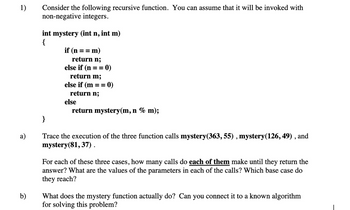
C++ Programming: From Problem Analysis to Program Design
8th Edition
ISBN: 9781337102087
Author: D. S. Malik
Publisher: Cengage Learning
expand_more
expand_more
format_list_bulleted
Question
Solve the questions on recursive function; please refer to the screenshot;

Transcribed Image Text:1)
a)
b)
Consider the following recursive function. You can assume that it will be invoked with
non-negative integers.
int mystery (int n,
{
}
= m)
if (n ==
return n;
int m)
else if (n == 0)
return m;
else if (m == 0)
return n;
else
return mystery(m, n % m);
Trace the execution of the three function calls mystery(363, 55), mystery(126, 49), and
mystery(81, 37).
For each of these three cases, how many calls do each of them make until they return the
answer? What are the values of the parameters in each of the calls? Which base case do
they reach?
What does the mystery function actually do? Can you connect it to a known algorithm
for solving this problem?
Expert Solution
This question has been solved!
Explore an expertly crafted, step-by-step solution for a thorough understanding of key concepts.
Step by stepSolved in 2 steps

Knowledge Booster
Similar questions
- Mark the following statements as true or false. A double type is an example of a simple data type. (1) A one-dimensional array is an example of a structured data type. (1) The size of an array is determined at compile time. (1,6) Given the declaration: int list[10]; the statement: list[5] - list[3] * list[2]; updates the content of the fifth component of the array list. (2) If an array index goes out of bounds, the program always terminates in an error. (3) The only aggregate operations allowable on int arrays are the increment and decrement operations. (5) Arrays can be passed as parameters to a function either by value or by reference. (6) A function can return a value of type array. (6) In C++, some aggregate operations are allowed for strings. (11,12,13) The declaration: char name [16] = "John K. Miller"; declares name to be an array of 15 characters because the string "John K. Miller" has only 14 characters. (11) The declaration: char str = "Sunny Day"; declares str to be a string of an unspecified length. (11) As parameters, two-dimensional arrays are passed either by value or by reference. (15,16)arrow_forward(Numerical) a. The following is an extremely useful programming algorithm for rounding a real number to n decimal places: Step 1: Multiply the number by 10n Step 2: Add 0.5 Step 3: Delete the fractional part of the result Step 4: Divide by 10n For example, using this algorithm to round the number 78.374625 to three decimal places yields: Step1:78.374625103=78374.625 Step2:78374.625+0.5=78375.125 Step3:Retainingtheintegerpart=78375Step4:78375dividedby103=78.375 Using this algorithm, write a C++ function that accepts a user-entered value and returns the result rounded to two decimal places. b. Enter, compile, and run the program written for Exercise 11a.arrow_forward(Electrical eng.) a. An engineer has constructed a two-dimensional array of real numbers with three rows and five columns. This array currently contains test voltages of an amplifier. Write a C++ program that interactively inputs 15 array values, and then determines the total number of voltages in these ranges: less than 60, greater than or equal to 60 and less than 70, greater than or equal to 70 and less than 80, greater than or equal to 80 and less than 90, and greater than or equal to 90. b. Entering 15 voltages each time the program written for Exercise 7a runs is cumbersome. What method could be used for initializing the array during the testing phase? c. How might the program you wrote for Exercise 7a be modified to include the case of no voltage being present? That is, what voltage could be used to indicate an invalid voltage, and how would your program have to be modified to exclude counting such a voltage?arrow_forward
arrow_back_ios
arrow_forward_ios
Recommended textbooks for you
 C++ Programming: From Problem Analysis to Program...Computer ScienceISBN:9781337102087Author:D. S. MalikPublisher:Cengage Learning
C++ Programming: From Problem Analysis to Program...Computer ScienceISBN:9781337102087Author:D. S. MalikPublisher:Cengage Learning C++ for Engineers and ScientistsComputer ScienceISBN:9781133187844Author:Bronson, Gary J.Publisher:Course Technology Ptr
C++ for Engineers and ScientistsComputer ScienceISBN:9781133187844Author:Bronson, Gary J.Publisher:Course Technology Ptr Systems ArchitectureComputer ScienceISBN:9781305080195Author:Stephen D. BurdPublisher:Cengage Learning
Systems ArchitectureComputer ScienceISBN:9781305080195Author:Stephen D. BurdPublisher:Cengage Learning- COMPREHENSIVE MICROSOFT OFFICE 365 EXCEComputer ScienceISBN:9780357392676Author:FREUND, StevenPublisher:CENGAGE LProgramming Logic & Design ComprehensiveComputer ScienceISBN:9781337669405Author:FARRELLPublisher:Cengage

C++ Programming: From Problem Analysis to Program...
Computer Science
ISBN:9781337102087
Author:D. S. Malik
Publisher:Cengage Learning

C++ for Engineers and Scientists
Computer Science
ISBN:9781133187844
Author:Bronson, Gary J.
Publisher:Course Technology Ptr

Systems Architecture
Computer Science
ISBN:9781305080195
Author:Stephen D. Burd
Publisher:Cengage Learning

COMPREHENSIVE MICROSOFT OFFICE 365 EXCE
Computer Science
ISBN:9780357392676
Author:FREUND, Steven
Publisher:CENGAGE L

Programming Logic & Design Comprehensive
Computer Science
ISBN:9781337669405
Author:FARRELL
Publisher:Cengage